System Thinking: Critical Solutions to Deforestation & Sustainability
VerifiedAdded on 2023/06/14
|10
|2666
|476
Essay
AI Summary
This essay examines the critical role of system thinking in developing solutions to sustainability challenges, focusing on the issue of deforestation. It argues that system thinking, with its multidisciplinary approach and emphasis on interrelationships, is essential for balancing economic development and environmental protection. The essay highlights how deforestation, driven by industrial growth and consumerism, poses a significant threat to sustainability. It discusses the importance of considering factors like forest canopy density, global warming, and the impact on local communities. The essay also explores the benefits of transparency and data-driven decision-making in forest management, while acknowledging the challenges of stakeholder conflicts and the need for adaptable approaches. Ultimately, it concludes that system thinking offers a valuable framework for addressing complex sustainability issues, despite its potential drawbacks.
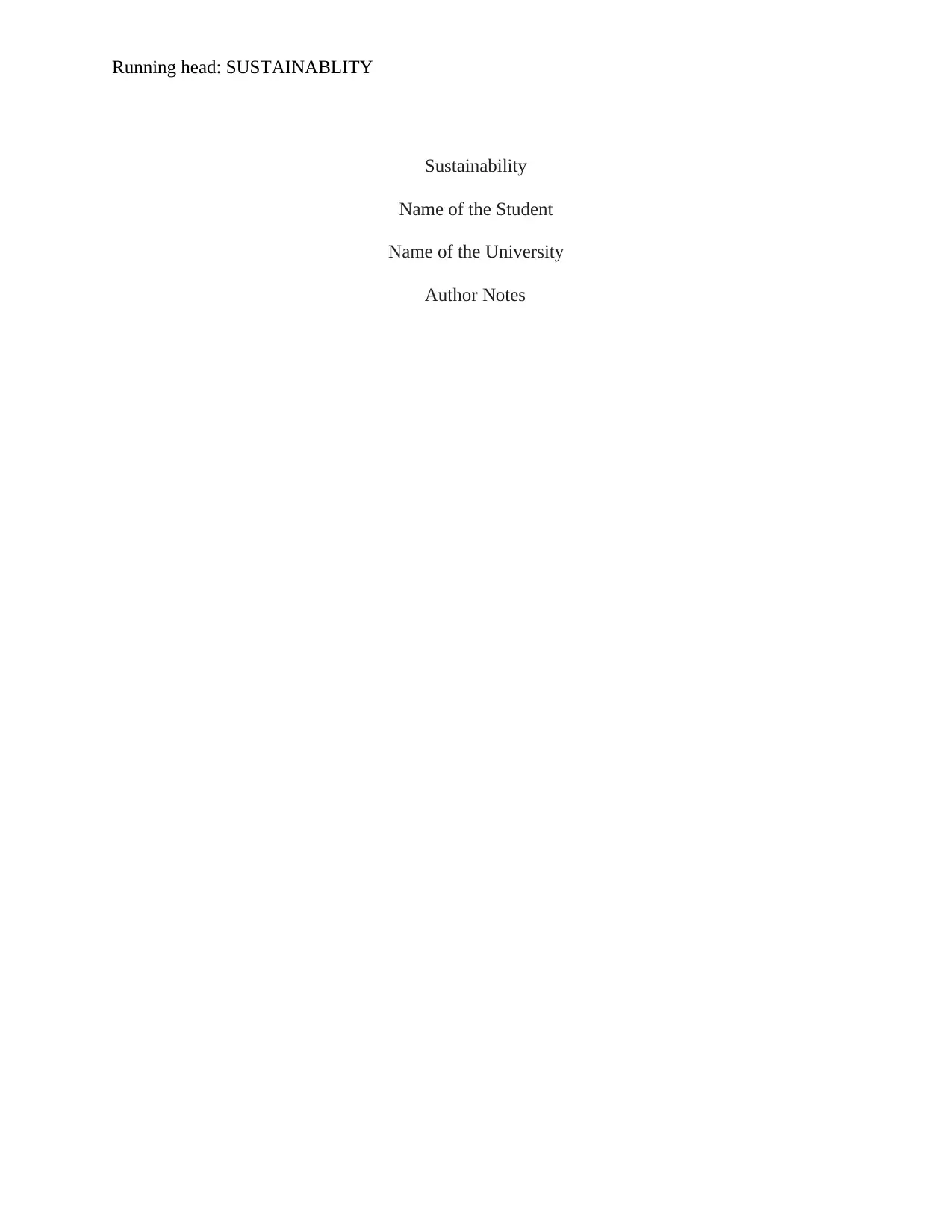
Running head: SUSTAINABLITY
Sustainability
Name of the Student
Name of the University
Author Notes
Sustainability
Name of the Student
Name of the University
Author Notes
Paraphrase This Document
Need a fresh take? Get an instant paraphrase of this document with our AI Paraphraser
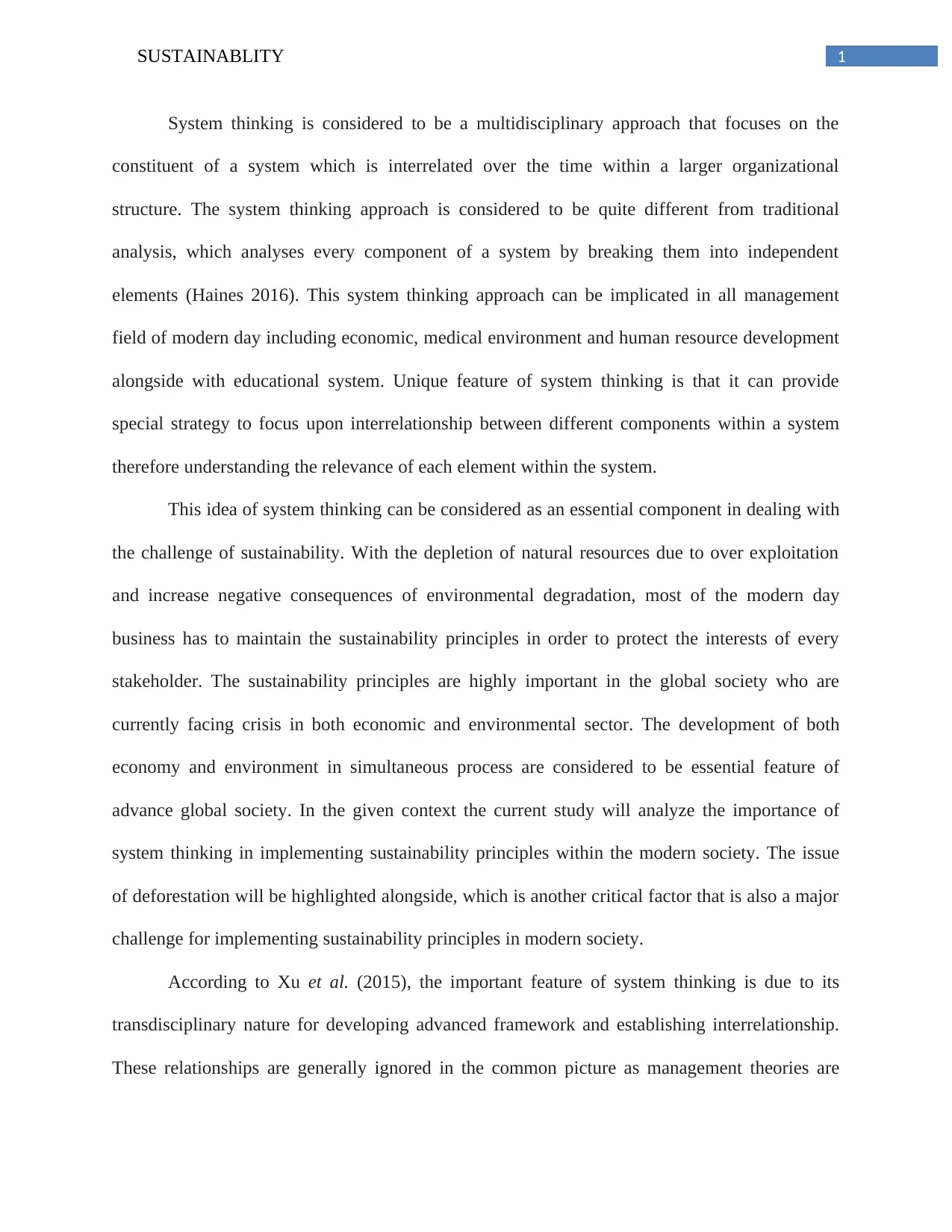
1SUSTAINABLITY
System thinking is considered to be a multidisciplinary approach that focuses on the
constituent of a system which is interrelated over the time within a larger organizational
structure. The system thinking approach is considered to be quite different from traditional
analysis, which analyses every component of a system by breaking them into independent
elements (Haines 2016). This system thinking approach can be implicated in all management
field of modern day including economic, medical environment and human resource development
alongside with educational system. Unique feature of system thinking is that it can provide
special strategy to focus upon interrelationship between different components within a system
therefore understanding the relevance of each element within the system.
This idea of system thinking can be considered as an essential component in dealing with
the challenge of sustainability. With the depletion of natural resources due to over exploitation
and increase negative consequences of environmental degradation, most of the modern day
business has to maintain the sustainability principles in order to protect the interests of every
stakeholder. The sustainability principles are highly important in the global society who are
currently facing crisis in both economic and environmental sector. The development of both
economy and environment in simultaneous process are considered to be essential feature of
advance global society. In the given context the current study will analyze the importance of
system thinking in implementing sustainability principles within the modern society. The issue
of deforestation will be highlighted alongside, which is another critical factor that is also a major
challenge for implementing sustainability principles in modern society.
According to Xu et al. (2015), the important feature of system thinking is due to its
transdisciplinary nature for developing advanced framework and establishing interrelationship.
These relationships are generally ignored in the common picture as management theories are
System thinking is considered to be a multidisciplinary approach that focuses on the
constituent of a system which is interrelated over the time within a larger organizational
structure. The system thinking approach is considered to be quite different from traditional
analysis, which analyses every component of a system by breaking them into independent
elements (Haines 2016). This system thinking approach can be implicated in all management
field of modern day including economic, medical environment and human resource development
alongside with educational system. Unique feature of system thinking is that it can provide
special strategy to focus upon interrelationship between different components within a system
therefore understanding the relevance of each element within the system.
This idea of system thinking can be considered as an essential component in dealing with
the challenge of sustainability. With the depletion of natural resources due to over exploitation
and increase negative consequences of environmental degradation, most of the modern day
business has to maintain the sustainability principles in order to protect the interests of every
stakeholder. The sustainability principles are highly important in the global society who are
currently facing crisis in both economic and environmental sector. The development of both
economy and environment in simultaneous process are considered to be essential feature of
advance global society. In the given context the current study will analyze the importance of
system thinking in implementing sustainability principles within the modern society. The issue
of deforestation will be highlighted alongside, which is another critical factor that is also a major
challenge for implementing sustainability principles in modern society.
According to Xu et al. (2015), the important feature of system thinking is due to its
transdisciplinary nature for developing advanced framework and establishing interrelationship.
These relationships are generally ignored in the common picture as management theories are
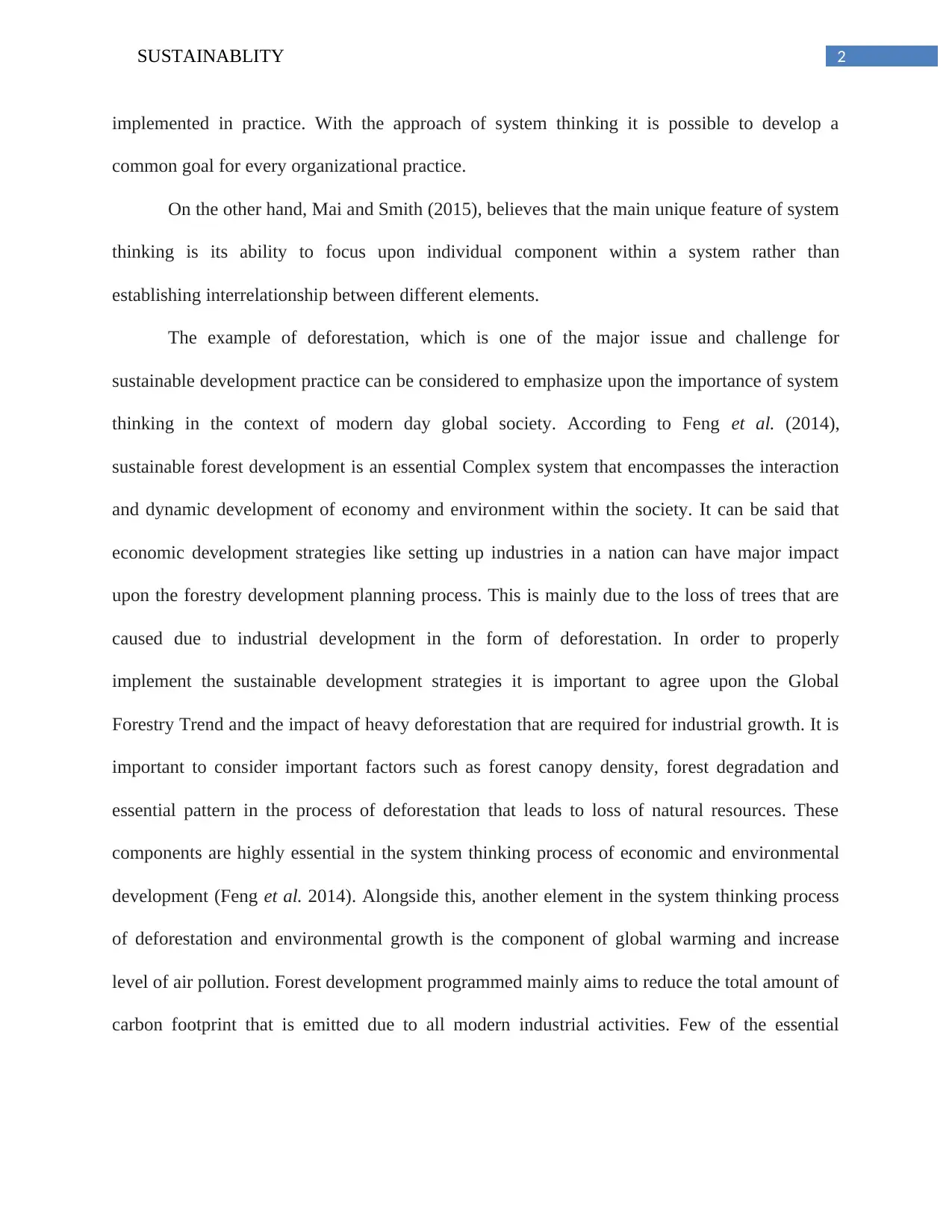
2SUSTAINABLITY
implemented in practice. With the approach of system thinking it is possible to develop a
common goal for every organizational practice.
On the other hand, Mai and Smith (2015), believes that the main unique feature of system
thinking is its ability to focus upon individual component within a system rather than
establishing interrelationship between different elements.
The example of deforestation, which is one of the major issue and challenge for
sustainable development practice can be considered to emphasize upon the importance of system
thinking in the context of modern day global society. According to Feng et al. (2014),
sustainable forest development is an essential Complex system that encompasses the interaction
and dynamic development of economy and environment within the society. It can be said that
economic development strategies like setting up industries in a nation can have major impact
upon the forestry development planning process. This is mainly due to the loss of trees that are
caused due to industrial development in the form of deforestation. In order to properly
implement the sustainable development strategies it is important to agree upon the Global
Forestry Trend and the impact of heavy deforestation that are required for industrial growth. It is
important to consider important factors such as forest canopy density, forest degradation and
essential pattern in the process of deforestation that leads to loss of natural resources. These
components are highly essential in the system thinking process of economic and environmental
development (Feng et al. 2014). Alongside this, another element in the system thinking process
of deforestation and environmental growth is the component of global warming and increase
level of air pollution. Forest development programmed mainly aims to reduce the total amount of
carbon footprint that is emitted due to all modern industrial activities. Few of the essential
implemented in practice. With the approach of system thinking it is possible to develop a
common goal for every organizational practice.
On the other hand, Mai and Smith (2015), believes that the main unique feature of system
thinking is its ability to focus upon individual component within a system rather than
establishing interrelationship between different elements.
The example of deforestation, which is one of the major issue and challenge for
sustainable development practice can be considered to emphasize upon the importance of system
thinking in the context of modern day global society. According to Feng et al. (2014),
sustainable forest development is an essential Complex system that encompasses the interaction
and dynamic development of economy and environment within the society. It can be said that
economic development strategies like setting up industries in a nation can have major impact
upon the forestry development planning process. This is mainly due to the loss of trees that are
caused due to industrial development in the form of deforestation. In order to properly
implement the sustainable development strategies it is important to agree upon the Global
Forestry Trend and the impact of heavy deforestation that are required for industrial growth. It is
important to consider important factors such as forest canopy density, forest degradation and
essential pattern in the process of deforestation that leads to loss of natural resources. These
components are highly essential in the system thinking process of economic and environmental
development (Feng et al. 2014). Alongside this, another element in the system thinking process
of deforestation and environmental growth is the component of global warming and increase
level of air pollution. Forest development programmed mainly aims to reduce the total amount of
carbon footprint that is emitted due to all modern industrial activities. Few of the essential
⊘ This is a preview!⊘
Do you want full access?
Subscribe today to unlock all pages.

Trusted by 1+ million students worldwide
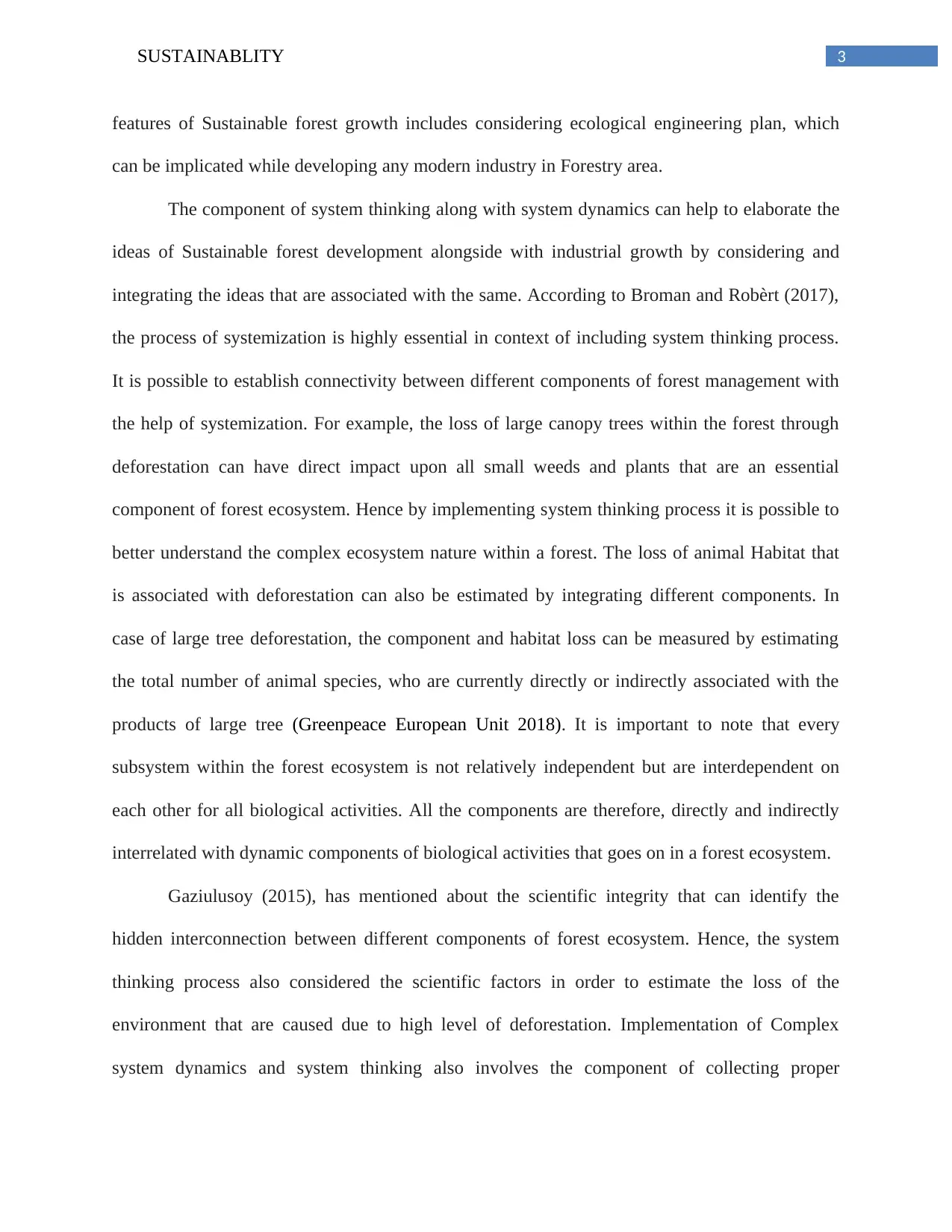
3SUSTAINABLITY
features of Sustainable forest growth includes considering ecological engineering plan, which
can be implicated while developing any modern industry in Forestry area.
The component of system thinking along with system dynamics can help to elaborate the
ideas of Sustainable forest development alongside with industrial growth by considering and
integrating the ideas that are associated with the same. According to Broman and Robèrt (2017),
the process of systemization is highly essential in context of including system thinking process.
It is possible to establish connectivity between different components of forest management with
the help of systemization. For example, the loss of large canopy trees within the forest through
deforestation can have direct impact upon all small weeds and plants that are an essential
component of forest ecosystem. Hence by implementing system thinking process it is possible to
better understand the complex ecosystem nature within a forest. The loss of animal Habitat that
is associated with deforestation can also be estimated by integrating different components. In
case of large tree deforestation, the component and habitat loss can be measured by estimating
the total number of animal species, who are currently directly or indirectly associated with the
products of large tree (Greenpeace European Unit 2018). It is important to note that every
subsystem within the forest ecosystem is not relatively independent but are interdependent on
each other for all biological activities. All the components are therefore, directly and indirectly
interrelated with dynamic components of biological activities that goes on in a forest ecosystem.
Gaziulusoy (2015), has mentioned about the scientific integrity that can identify the
hidden interconnection between different components of forest ecosystem. Hence, the system
thinking process also considered the scientific factors in order to estimate the loss of the
environment that are caused due to high level of deforestation. Implementation of Complex
system dynamics and system thinking also involves the component of collecting proper
features of Sustainable forest growth includes considering ecological engineering plan, which
can be implicated while developing any modern industry in Forestry area.
The component of system thinking along with system dynamics can help to elaborate the
ideas of Sustainable forest development alongside with industrial growth by considering and
integrating the ideas that are associated with the same. According to Broman and Robèrt (2017),
the process of systemization is highly essential in context of including system thinking process.
It is possible to establish connectivity between different components of forest management with
the help of systemization. For example, the loss of large canopy trees within the forest through
deforestation can have direct impact upon all small weeds and plants that are an essential
component of forest ecosystem. Hence by implementing system thinking process it is possible to
better understand the complex ecosystem nature within a forest. The loss of animal Habitat that
is associated with deforestation can also be estimated by integrating different components. In
case of large tree deforestation, the component and habitat loss can be measured by estimating
the total number of animal species, who are currently directly or indirectly associated with the
products of large tree (Greenpeace European Unit 2018). It is important to note that every
subsystem within the forest ecosystem is not relatively independent but are interdependent on
each other for all biological activities. All the components are therefore, directly and indirectly
interrelated with dynamic components of biological activities that goes on in a forest ecosystem.
Gaziulusoy (2015), has mentioned about the scientific integrity that can identify the
hidden interconnection between different components of forest ecosystem. Hence, the system
thinking process also considered the scientific factors in order to estimate the loss of the
environment that are caused due to high level of deforestation. Implementation of Complex
system dynamics and system thinking also involves the component of collecting proper
Paraphrase This Document
Need a fresh take? Get an instant paraphrase of this document with our AI Paraphraser
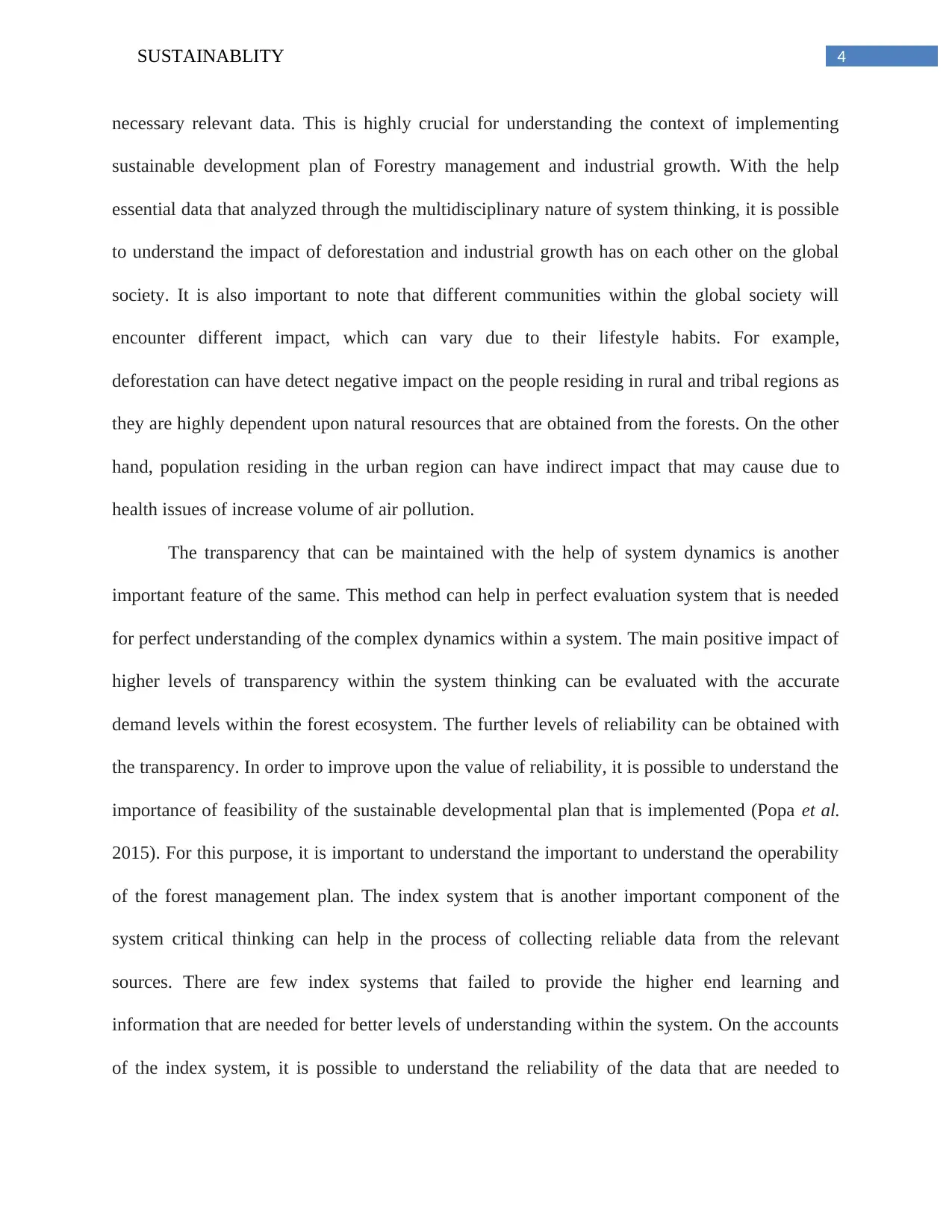
4SUSTAINABLITY
necessary relevant data. This is highly crucial for understanding the context of implementing
sustainable development plan of Forestry management and industrial growth. With the help
essential data that analyzed through the multidisciplinary nature of system thinking, it is possible
to understand the impact of deforestation and industrial growth has on each other on the global
society. It is also important to note that different communities within the global society will
encounter different impact, which can vary due to their lifestyle habits. For example,
deforestation can have detect negative impact on the people residing in rural and tribal regions as
they are highly dependent upon natural resources that are obtained from the forests. On the other
hand, population residing in the urban region can have indirect impact that may cause due to
health issues of increase volume of air pollution.
The transparency that can be maintained with the help of system dynamics is another
important feature of the same. This method can help in perfect evaluation system that is needed
for perfect understanding of the complex dynamics within a system. The main positive impact of
higher levels of transparency within the system thinking can be evaluated with the accurate
demand levels within the forest ecosystem. The further levels of reliability can be obtained with
the transparency. In order to improve upon the value of reliability, it is possible to understand the
importance of feasibility of the sustainable developmental plan that is implemented (Popa et al.
2015). For this purpose, it is important to understand the important to understand the operability
of the forest management plan. The index system that is another important component of the
system critical thinking can help in the process of collecting reliable data from the relevant
sources. There are few index systems that failed to provide the higher end learning and
information that are needed for better levels of understanding within the system. On the accounts
of the index system, it is possible to understand the reliability of the data that are needed to
necessary relevant data. This is highly crucial for understanding the context of implementing
sustainable development plan of Forestry management and industrial growth. With the help
essential data that analyzed through the multidisciplinary nature of system thinking, it is possible
to understand the impact of deforestation and industrial growth has on each other on the global
society. It is also important to note that different communities within the global society will
encounter different impact, which can vary due to their lifestyle habits. For example,
deforestation can have detect negative impact on the people residing in rural and tribal regions as
they are highly dependent upon natural resources that are obtained from the forests. On the other
hand, population residing in the urban region can have indirect impact that may cause due to
health issues of increase volume of air pollution.
The transparency that can be maintained with the help of system dynamics is another
important feature of the same. This method can help in perfect evaluation system that is needed
for perfect understanding of the complex dynamics within a system. The main positive impact of
higher levels of transparency within the system thinking can be evaluated with the accurate
demand levels within the forest ecosystem. The further levels of reliability can be obtained with
the transparency. In order to improve upon the value of reliability, it is possible to understand the
importance of feasibility of the sustainable developmental plan that is implemented (Popa et al.
2015). For this purpose, it is important to understand the important to understand the operability
of the forest management plan. The index system that is another important component of the
system critical thinking can help in the process of collecting reliable data from the relevant
sources. There are few index systems that failed to provide the higher end learning and
information that are needed for better levels of understanding within the system. On the accounts
of the index system, it is possible to understand the reliability of the data that are needed to
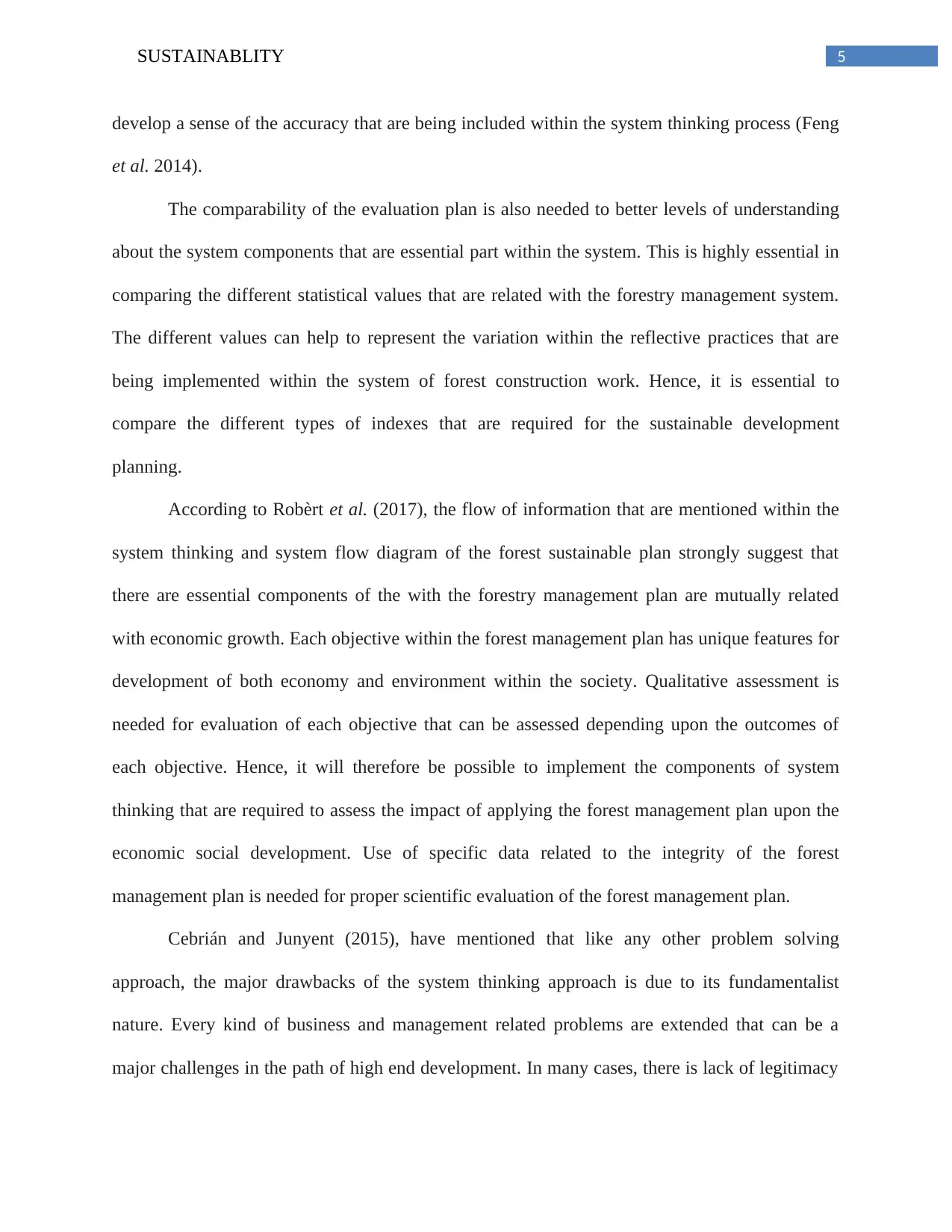
5SUSTAINABLITY
develop a sense of the accuracy that are being included within the system thinking process (Feng
et al. 2014).
The comparability of the evaluation plan is also needed to better levels of understanding
about the system components that are essential part within the system. This is highly essential in
comparing the different statistical values that are related with the forestry management system.
The different values can help to represent the variation within the reflective practices that are
being implemented within the system of forest construction work. Hence, it is essential to
compare the different types of indexes that are required for the sustainable development
planning.
According to Robèrt et al. (2017), the flow of information that are mentioned within the
system thinking and system flow diagram of the forest sustainable plan strongly suggest that
there are essential components of the with the forestry management plan are mutually related
with economic growth. Each objective within the forest management plan has unique features for
development of both economy and environment within the society. Qualitative assessment is
needed for evaluation of each objective that can be assessed depending upon the outcomes of
each objective. Hence, it will therefore be possible to implement the components of system
thinking that are required to assess the impact of applying the forest management plan upon the
economic social development. Use of specific data related to the integrity of the forest
management plan is needed for proper scientific evaluation of the forest management plan.
Cebrián and Junyent (2015), have mentioned that like any other problem solving
approach, the major drawbacks of the system thinking approach is due to its fundamentalist
nature. Every kind of business and management related problems are extended that can be a
major challenges in the path of high end development. In many cases, there is lack of legitimacy
develop a sense of the accuracy that are being included within the system thinking process (Feng
et al. 2014).
The comparability of the evaluation plan is also needed to better levels of understanding
about the system components that are essential part within the system. This is highly essential in
comparing the different statistical values that are related with the forestry management system.
The different values can help to represent the variation within the reflective practices that are
being implemented within the system of forest construction work. Hence, it is essential to
compare the different types of indexes that are required for the sustainable development
planning.
According to Robèrt et al. (2017), the flow of information that are mentioned within the
system thinking and system flow diagram of the forest sustainable plan strongly suggest that
there are essential components of the with the forestry management plan are mutually related
with economic growth. Each objective within the forest management plan has unique features for
development of both economy and environment within the society. Qualitative assessment is
needed for evaluation of each objective that can be assessed depending upon the outcomes of
each objective. Hence, it will therefore be possible to implement the components of system
thinking that are required to assess the impact of applying the forest management plan upon the
economic social development. Use of specific data related to the integrity of the forest
management plan is needed for proper scientific evaluation of the forest management plan.
Cebrián and Junyent (2015), have mentioned that like any other problem solving
approach, the major drawbacks of the system thinking approach is due to its fundamentalist
nature. Every kind of business and management related problems are extended that can be a
major challenges in the path of high end development. In many cases, there is lack of legitimacy
⊘ This is a preview!⊘
Do you want full access?
Subscribe today to unlock all pages.

Trusted by 1+ million students worldwide
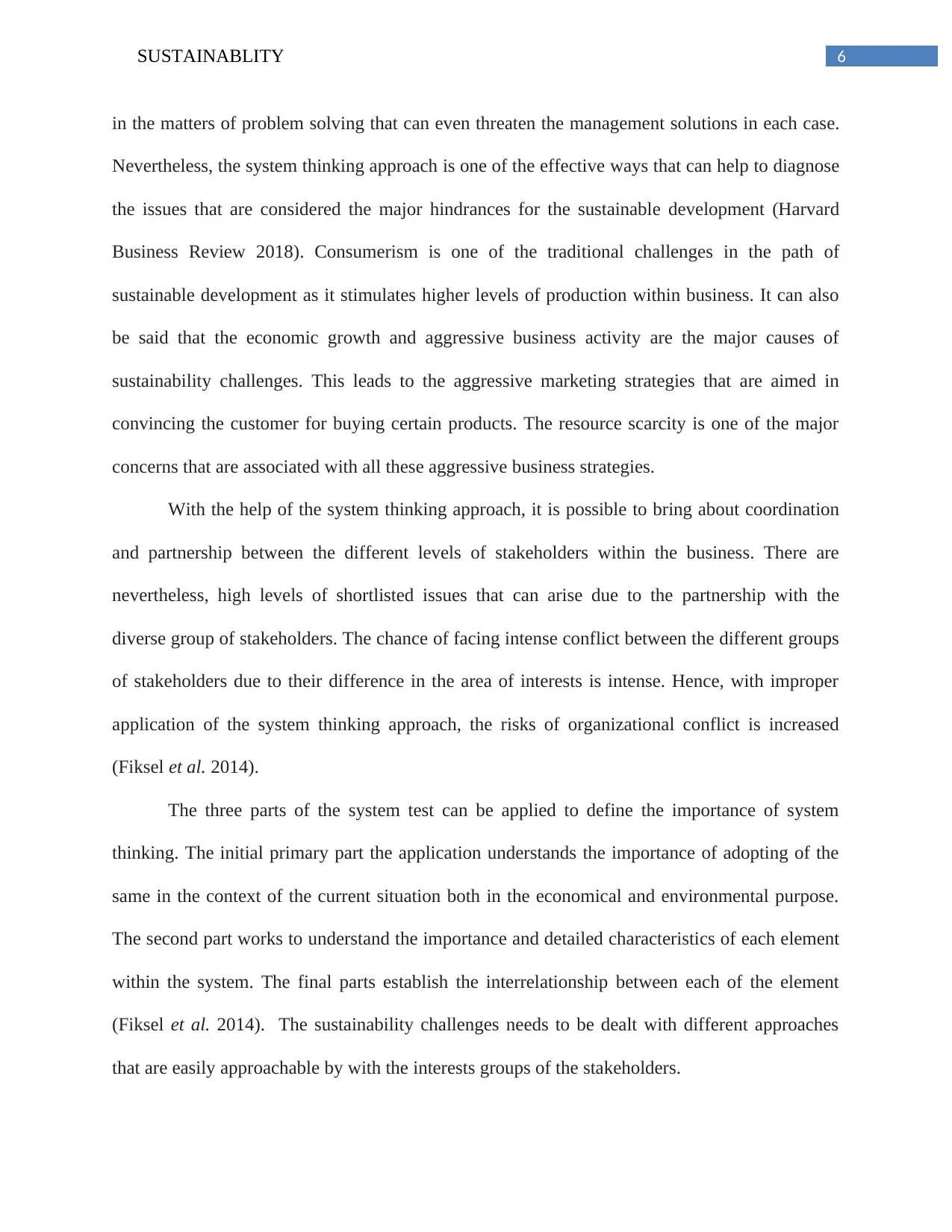
6SUSTAINABLITY
in the matters of problem solving that can even threaten the management solutions in each case.
Nevertheless, the system thinking approach is one of the effective ways that can help to diagnose
the issues that are considered the major hindrances for the sustainable development (Harvard
Business Review 2018). Consumerism is one of the traditional challenges in the path of
sustainable development as it stimulates higher levels of production within business. It can also
be said that the economic growth and aggressive business activity are the major causes of
sustainability challenges. This leads to the aggressive marketing strategies that are aimed in
convincing the customer for buying certain products. The resource scarcity is one of the major
concerns that are associated with all these aggressive business strategies.
With the help of the system thinking approach, it is possible to bring about coordination
and partnership between the different levels of stakeholders within the business. There are
nevertheless, high levels of shortlisted issues that can arise due to the partnership with the
diverse group of stakeholders. The chance of facing intense conflict between the different groups
of stakeholders due to their difference in the area of interests is intense. Hence, with improper
application of the system thinking approach, the risks of organizational conflict is increased
(Fiksel et al. 2014).
The three parts of the system test can be applied to define the importance of system
thinking. The initial primary part the application understands the importance of adopting of the
same in the context of the current situation both in the economical and environmental purpose.
The second part works to understand the importance and detailed characteristics of each element
within the system. The final parts establish the interrelationship between each of the element
(Fiksel et al. 2014). The sustainability challenges needs to be dealt with different approaches
that are easily approachable by with the interests groups of the stakeholders.
in the matters of problem solving that can even threaten the management solutions in each case.
Nevertheless, the system thinking approach is one of the effective ways that can help to diagnose
the issues that are considered the major hindrances for the sustainable development (Harvard
Business Review 2018). Consumerism is one of the traditional challenges in the path of
sustainable development as it stimulates higher levels of production within business. It can also
be said that the economic growth and aggressive business activity are the major causes of
sustainability challenges. This leads to the aggressive marketing strategies that are aimed in
convincing the customer for buying certain products. The resource scarcity is one of the major
concerns that are associated with all these aggressive business strategies.
With the help of the system thinking approach, it is possible to bring about coordination
and partnership between the different levels of stakeholders within the business. There are
nevertheless, high levels of shortlisted issues that can arise due to the partnership with the
diverse group of stakeholders. The chance of facing intense conflict between the different groups
of stakeholders due to their difference in the area of interests is intense. Hence, with improper
application of the system thinking approach, the risks of organizational conflict is increased
(Fiksel et al. 2014).
The three parts of the system test can be applied to define the importance of system
thinking. The initial primary part the application understands the importance of adopting of the
same in the context of the current situation both in the economical and environmental purpose.
The second part works to understand the importance and detailed characteristics of each element
within the system. The final parts establish the interrelationship between each of the element
(Fiksel et al. 2014). The sustainability challenges needs to be dealt with different approaches
that are easily approachable by with the interests groups of the stakeholders.
Paraphrase This Document
Need a fresh take? Get an instant paraphrase of this document with our AI Paraphraser
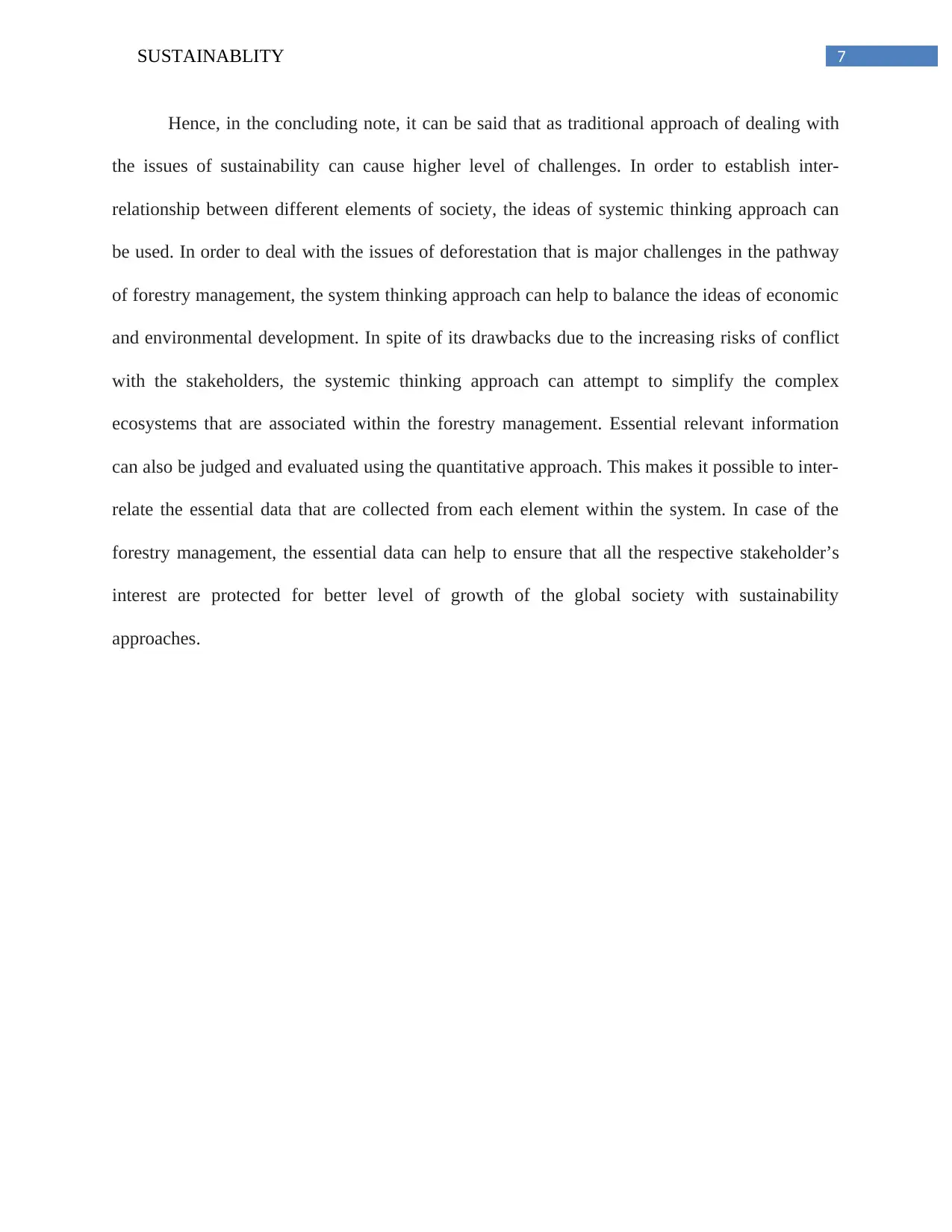
7SUSTAINABLITY
Hence, in the concluding note, it can be said that as traditional approach of dealing with
the issues of sustainability can cause higher level of challenges. In order to establish inter-
relationship between different elements of society, the ideas of systemic thinking approach can
be used. In order to deal with the issues of deforestation that is major challenges in the pathway
of forestry management, the system thinking approach can help to balance the ideas of economic
and environmental development. In spite of its drawbacks due to the increasing risks of conflict
with the stakeholders, the systemic thinking approach can attempt to simplify the complex
ecosystems that are associated within the forestry management. Essential relevant information
can also be judged and evaluated using the quantitative approach. This makes it possible to inter-
relate the essential data that are collected from each element within the system. In case of the
forestry management, the essential data can help to ensure that all the respective stakeholder’s
interest are protected for better level of growth of the global society with sustainability
approaches.
Hence, in the concluding note, it can be said that as traditional approach of dealing with
the issues of sustainability can cause higher level of challenges. In order to establish inter-
relationship between different elements of society, the ideas of systemic thinking approach can
be used. In order to deal with the issues of deforestation that is major challenges in the pathway
of forestry management, the system thinking approach can help to balance the ideas of economic
and environmental development. In spite of its drawbacks due to the increasing risks of conflict
with the stakeholders, the systemic thinking approach can attempt to simplify the complex
ecosystems that are associated within the forestry management. Essential relevant information
can also be judged and evaluated using the quantitative approach. This makes it possible to inter-
relate the essential data that are collected from each element within the system. In case of the
forestry management, the essential data can help to ensure that all the respective stakeholder’s
interest are protected for better level of growth of the global society with sustainability
approaches.
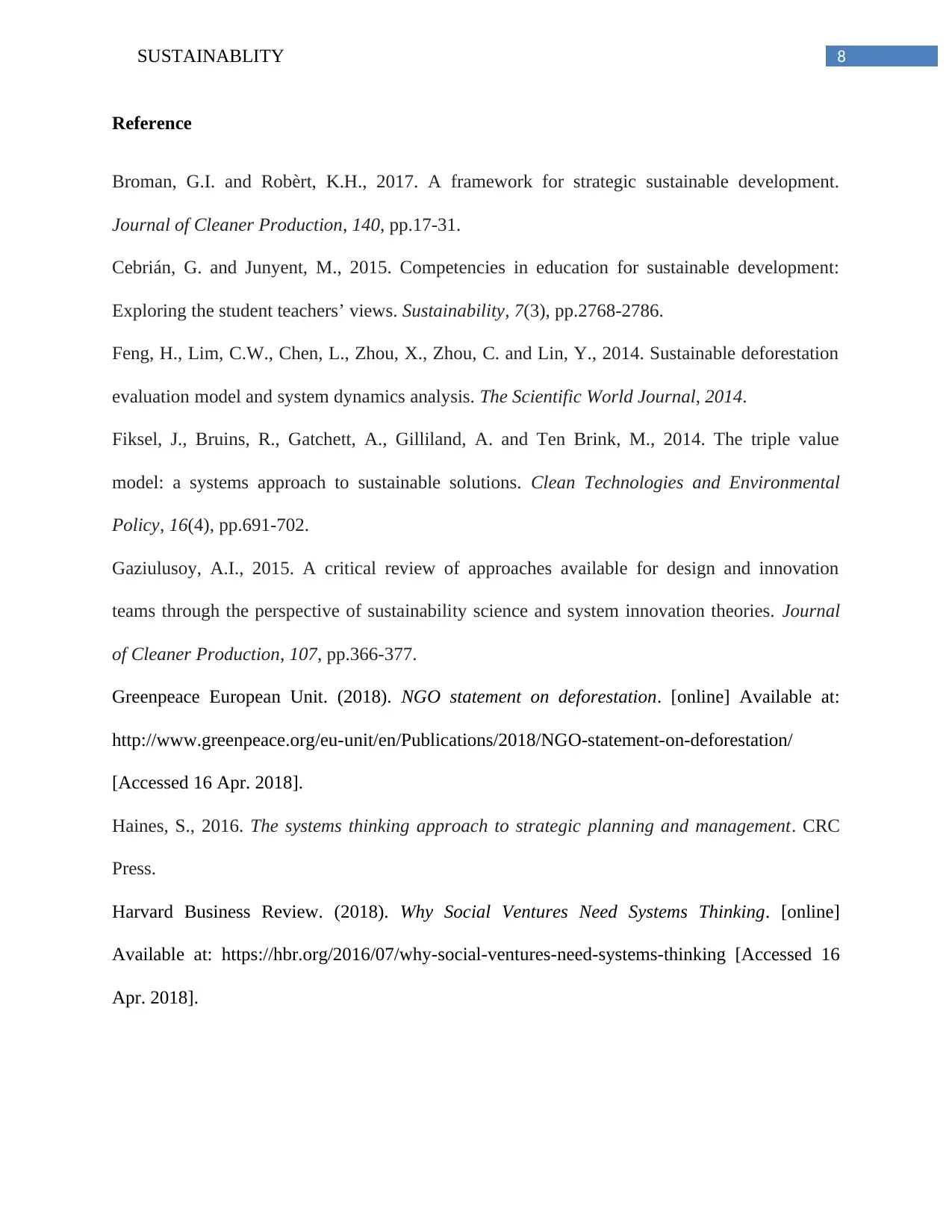
8SUSTAINABLITY
Reference
Broman, G.I. and Robèrt, K.H., 2017. A framework for strategic sustainable development.
Journal of Cleaner Production, 140, pp.17-31.
Cebrián, G. and Junyent, M., 2015. Competencies in education for sustainable development:
Exploring the student teachers’ views. Sustainability, 7(3), pp.2768-2786.
Feng, H., Lim, C.W., Chen, L., Zhou, X., Zhou, C. and Lin, Y., 2014. Sustainable deforestation
evaluation model and system dynamics analysis. The Scientific World Journal, 2014.
Fiksel, J., Bruins, R., Gatchett, A., Gilliland, A. and Ten Brink, M., 2014. The triple value
model: a systems approach to sustainable solutions. Clean Technologies and Environmental
Policy, 16(4), pp.691-702.
Gaziulusoy, A.I., 2015. A critical review of approaches available for design and innovation
teams through the perspective of sustainability science and system innovation theories. Journal
of Cleaner Production, 107, pp.366-377.
Greenpeace European Unit. (2018). NGO statement on deforestation. [online] Available at:
http://www.greenpeace.org/eu-unit/en/Publications/2018/NGO-statement-on-deforestation/
[Accessed 16 Apr. 2018].
Haines, S., 2016. The systems thinking approach to strategic planning and management. CRC
Press.
Harvard Business Review. (2018). Why Social Ventures Need Systems Thinking. [online]
Available at: https://hbr.org/2016/07/why-social-ventures-need-systems-thinking [Accessed 16
Apr. 2018].
Reference
Broman, G.I. and Robèrt, K.H., 2017. A framework for strategic sustainable development.
Journal of Cleaner Production, 140, pp.17-31.
Cebrián, G. and Junyent, M., 2015. Competencies in education for sustainable development:
Exploring the student teachers’ views. Sustainability, 7(3), pp.2768-2786.
Feng, H., Lim, C.W., Chen, L., Zhou, X., Zhou, C. and Lin, Y., 2014. Sustainable deforestation
evaluation model and system dynamics analysis. The Scientific World Journal, 2014.
Fiksel, J., Bruins, R., Gatchett, A., Gilliland, A. and Ten Brink, M., 2014. The triple value
model: a systems approach to sustainable solutions. Clean Technologies and Environmental
Policy, 16(4), pp.691-702.
Gaziulusoy, A.I., 2015. A critical review of approaches available for design and innovation
teams through the perspective of sustainability science and system innovation theories. Journal
of Cleaner Production, 107, pp.366-377.
Greenpeace European Unit. (2018). NGO statement on deforestation. [online] Available at:
http://www.greenpeace.org/eu-unit/en/Publications/2018/NGO-statement-on-deforestation/
[Accessed 16 Apr. 2018].
Haines, S., 2016. The systems thinking approach to strategic planning and management. CRC
Press.
Harvard Business Review. (2018). Why Social Ventures Need Systems Thinking. [online]
Available at: https://hbr.org/2016/07/why-social-ventures-need-systems-thinking [Accessed 16
Apr. 2018].
⊘ This is a preview!⊘
Do you want full access?
Subscribe today to unlock all pages.

Trusted by 1+ million students worldwide
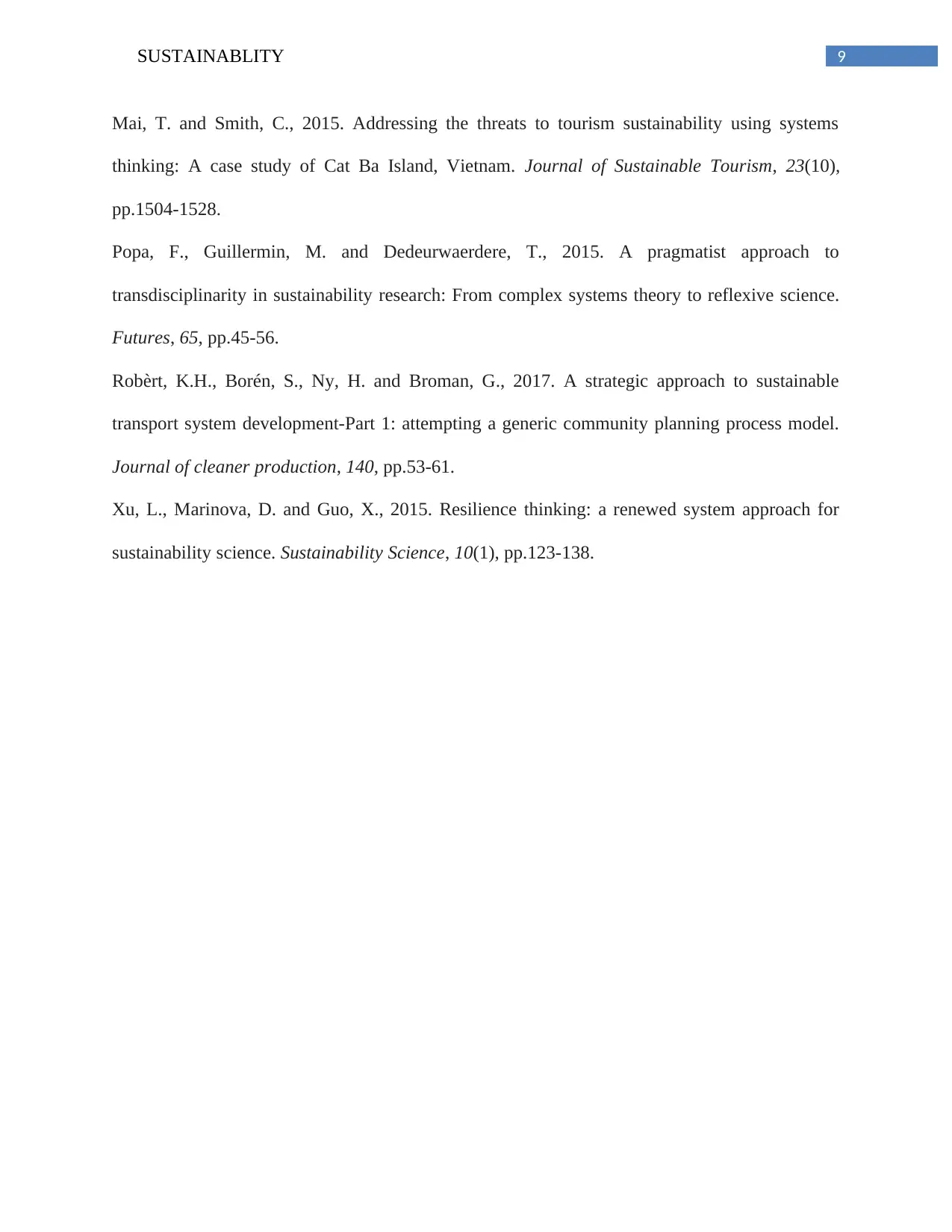
9SUSTAINABLITY
Mai, T. and Smith, C., 2015. Addressing the threats to tourism sustainability using systems
thinking: A case study of Cat Ba Island, Vietnam. Journal of Sustainable Tourism, 23(10),
pp.1504-1528.
Popa, F., Guillermin, M. and Dedeurwaerdere, T., 2015. A pragmatist approach to
transdisciplinarity in sustainability research: From complex systems theory to reflexive science.
Futures, 65, pp.45-56.
Robèrt, K.H., Borén, S., Ny, H. and Broman, G., 2017. A strategic approach to sustainable
transport system development-Part 1: attempting a generic community planning process model.
Journal of cleaner production, 140, pp.53-61.
Xu, L., Marinova, D. and Guo, X., 2015. Resilience thinking: a renewed system approach for
sustainability science. Sustainability Science, 10(1), pp.123-138.
Mai, T. and Smith, C., 2015. Addressing the threats to tourism sustainability using systems
thinking: A case study of Cat Ba Island, Vietnam. Journal of Sustainable Tourism, 23(10),
pp.1504-1528.
Popa, F., Guillermin, M. and Dedeurwaerdere, T., 2015. A pragmatist approach to
transdisciplinarity in sustainability research: From complex systems theory to reflexive science.
Futures, 65, pp.45-56.
Robèrt, K.H., Borén, S., Ny, H. and Broman, G., 2017. A strategic approach to sustainable
transport system development-Part 1: attempting a generic community planning process model.
Journal of cleaner production, 140, pp.53-61.
Xu, L., Marinova, D. and Guo, X., 2015. Resilience thinking: a renewed system approach for
sustainability science. Sustainability Science, 10(1), pp.123-138.
1 out of 10
Related Documents
Your All-in-One AI-Powered Toolkit for Academic Success.
+13062052269
info@desklib.com
Available 24*7 on WhatsApp / Email
![[object Object]](/_next/static/media/star-bottom.7253800d.svg)
Unlock your academic potential
Copyright © 2020–2025 A2Z Services. All Rights Reserved. Developed and managed by ZUCOL.




